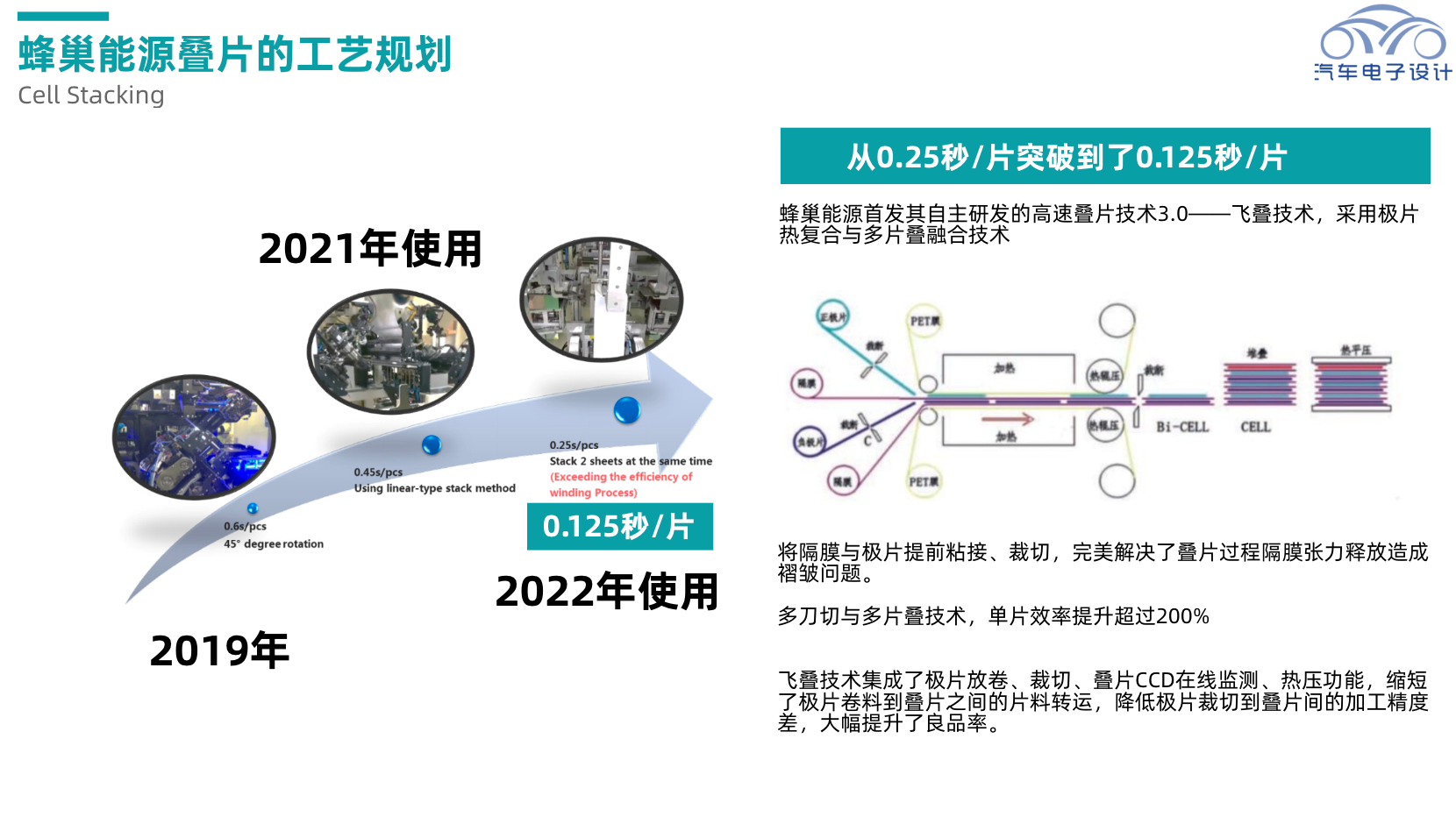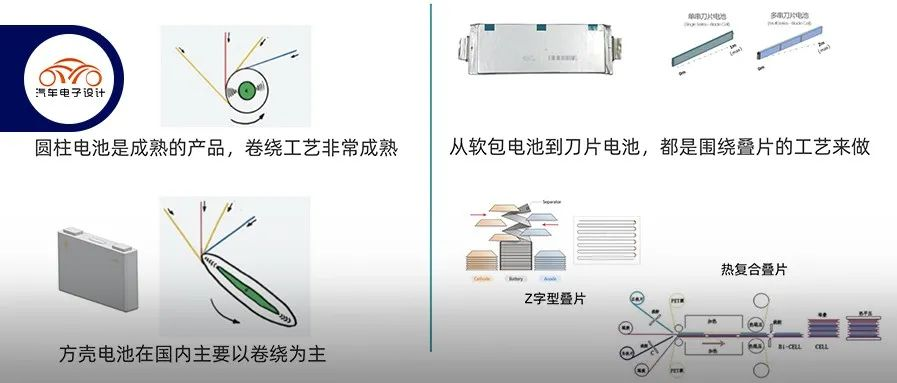Author: Zhu Yulong
There has been a continuous discussion around the choice of technical route for power batteries, focusing on cylindrical, pouch, and prismatic cells. Similarly, in the manufacturing process of mid-section cell assembly of lithium batteries, stacking technology and winding technology are also in long-term competition.
These two schemes are constantly competing with each other in terms of space utilization, cell lifespan, efficiency of manufacturing, and manufacturing investment.
- Winding technology
This is a production process that rolls up the electrode sheets that match in size with the separator and termination tapes, by controlling factors such as the speed, tension, size, and deviation of the electrode sheets.
- Stacking technology
This is a production process that alternates stacking electrode sheets and separators, and finally completes a multi-layer stacked electrode core.
As shown in the figure below, in terms of cell shape, pouch and prismatic cells are designed and produced based on the stacking technology, while square cells can use both stacking and winding technologies. The main technological direction in China is still based on winding technology, and cylindrical cells have always adopted winding technology as a mature product form.

From the perspective of China’s long-term technological development direction, with the advancement of stacking technology, many battery companies are gradually transitioning from the original winding process to the stacking era. Here, we can take a look at some information recently released by Honeycomb Energy.
Evolution of Honeycomb’s Stacking Technology
First, let’s take a look at the benefits brought by stacking technology.
From the perspective of the final battery product, the cell products formed by stacking have higher energy density, more stable internal structure, higher safety, and longer lifespan.
Higher Energy Density
From the inside of the battery cell, the winding process has a curved angle at the windings, which results in slightly lower space utilization. Stacked design can fully utilize the battery space and achieve higher energy density for cells with the same volume.
More Stable Structure
During the use of the battery, the insertion of lithium ions causes both positive and negative electrode plates to expand. The inconsistent internal and external stresses at the winding corners can cause the winding battery to undergo a wavy deformation, leading to poor battery interfaces, uneven current distribution, and accelerated instability of the internal structure of the battery.
Although the stacked design will also expand during the battery’s repeated use, the swelling force of each layer is almost the same, which can keep the interface flat and maintain a more stable structure.
Higher Safety
When the bottom two electrode plates of the winding design are bent, the coating material may experience significant bending deformation, resulting in powder shedding and burrs. The tension on the electrode plates and separators can become uneven, causing creases. The expansion and contraction of the electrode plates, stretching of the separator, and other issues can lead to battery deformation. In contrast, the stacked design distributes force evenly and has a higher level of safety in this regard.
Longer Cycle Life
The stacked design features more tabs, resulting in shorter electron transmission distances and lower resistance. As a result, the internal resistance of stacked cells gets lowered, and heat generation is reduced. Winding design, on the other hand, is prone to deformation and expansion, compromising the battery’s performance degradation over time.In the field of manufacturing shell batteries in China, Honeycomb Energy is the first company to use stacking technology. Since entering the industry in 2018, Honeycomb Energy has been advocating for power batteries to move from the “coil era” to the “stacking era.” In 2019, Honeycomb Energy made its debut and showcased its long stacked cell with an internal code name “L600.” The production efficiency of the first phase of the production line has been improved to 0.6 seconds per piece per single station. At that time, the planned speed path for stacking was 0.6 seconds per piece to 0.45 seconds. In the second phase of official production, Honeycomb Energy constructed the first “short knife” battery production line. The Honeycomb Z-shaped stacking machine has already achieved a stacking speed of 0.45 seconds per piece.
At the current point in time, Honeycomb Energy’s self-developed high-speed stacking technology 3.0 adopts the technology of extreme film hot-composite and multi-piece stacking fusion, achieving a revolutionary breakthrough in efficiency through technical innovation, with a stacking speed of 0.125 seconds per piece. This simplifies the mid-section process, saves more than 40% of the unit area, and solves the pain points of defect control and monitoring such as diaphragm folding and poor alignment accuracy through improved efficiency and precision.

The combination of stacking technology and the short knife scheme also requires some background to understand.The L600 stacked lithium iron phosphate battery cells from Honeycomb Energy, with a length of about 600mm, have officially entered mass production at the Honeycomb Energy Changzhou Jintan factory, achieving a single cell energy density of 175Wh/kg, over 4000 cycles of lifespan, fast charging from 0-80% SOC, and charging time less than 45 minutes. Due to process problems, the production process of this type of battery has always been affected by the relatively low stacking efficiency of the cells. However, through equipment integration – multiple pieces cut and stacked simultaneously on the stacking equipment – a more efficient output with simpler mechanisms has been achieved, resulting in an efficiency improvement of over 200% under the same single-machine equipment costs. This has strongly complemented the design of the short-blade battery and high-speed stacking, achieving a perfect “chemical reaction”.

Currently, Honeycomb Energy has fully transitioned to the “short-blade” battery series, which shows benefits mainly in the design aspect, such as higher volumetric energy density, the ability to be used as structural components for CTP, cost reduction, improved heat dissipation, and good safety performance.
Moreover, the “short-blade” battery is also adaptable and exists in multiple lengths such as L300, L400, L500, and L600, which can accommodate over 80% of passenger cars and can be used in different application environments. Previously, the main bottleneck was in large-scale production. Through the introduction of this technology, the production process has become more achievable, achieving higher yields through integrated technology such as roll unwinding, cutting, stacking CCD online monitoring, and hot pressing functions, shortening the transfer time of pole pieces from unwinding to stacking, and reducing the machining accuracy difference from pole piece cutting to stacking, greatly improving the yield.
Therefore, we are also considering why the pairing of short-blade and stacking technology is so perfect.We can see that the blade design is not suitable for the winding process. From experience, the winding length cannot exceed 300mm. Currently, the length of battery cells supported by mass-produced winding processes is between 280mm to 300mm, and this size range is currently the main coverage for square shell.
Through process design, the alignment accuracy of the honeycomb stacking process is ±0.3mm, and the stacking speed is 0.125 seconds. The technical and cost advantages of the short blade battery are more prominent. The combination of high-performance short blade batteries and efficient high-speed stacking technology forms a closed-loop solution.
Future Prospects for Technical Solutions
The development directions of cylindrical, square shell, and soft pack batteries are different. Each has its own advantages.
From the current technical scene:
-
Cylindrical: Standardization of 4680, winding, further improvement of the production speed of individual battery cells, and expansion of usage scenarios.
-
Soft pack: Transitioning to short and long blade batteries, which has greater advantages in using stacking technology.
-
Square shell: Continuing to use winding is a reasonable option if the existing size is maintained. However, if it is developed into a square shell stacking transition size and becomes a short and long blade, stacking technology will be naturally utilized.

To evaluate the two technical routes based on comprehensive manufacturing efficiency and yield:
-
The one with the greatest potential is the winding of large cylindrical batteries. The most important aspect is to begin introducing the dry electrode process for mature processes, and we have great imaginative space for this.
-
The one that has the fastest development is stacking. As Hengdian Group and Yawei Lithium Energy, and other power battery companies continue to follow suit with continuous innovation of stacking technology by Honeycomb Energy, Chinese battery companies are all beginning to design towards a super stacking + blade battery scheme, which has the greatest potential.- Stable development is the trend of winding: The winding of cylindrical shell remains unchanged, and we have also seen that in terms of the original production capacity construction, this route is the largest.
Conclusion: Battery companies have to make choices around process selection, but the trend is becoming increasingly clear. With the development of technological innovation, the era of TWh-scale production of power batteries is an unavoidable point for every battery company. Whoever can do this well can find their fundamental foothold in the stage where power batteries become largescale standardized products.
This article is a translation by ChatGPT of a Chinese report from 42HOW. If you have any questions about it, please email bd@42how.com.
